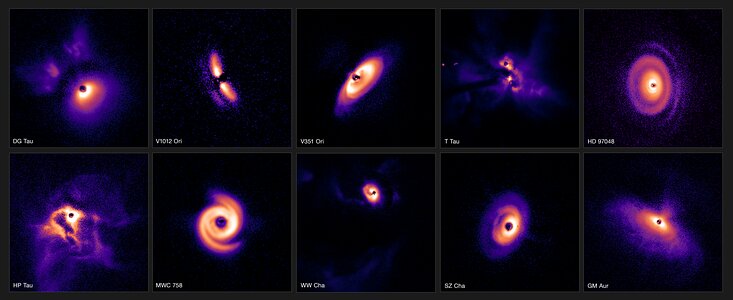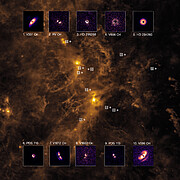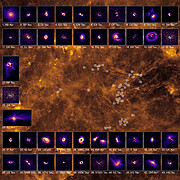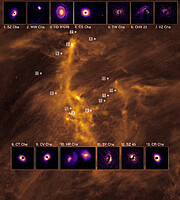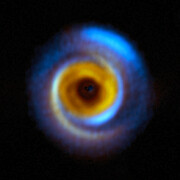Komunikat prasowy
Przełomowy naziemny przegląd nieba ujawnia sekrety narodzin planet wokół kilkudziesięciu gwiazd
5 marca 2024
W serii badań zespół astronomów rzucił nowe światło na fascynujący i skomplikowany proces powstawania planet. Oszałamiające zdjęcia uzyskane przy pomocy Bardzo Dużego Teleskopu (VLT) w Chile, należącego do ESO, pokazują jeden z największych w historii przeglądów dysków, w których formują się planet. Badania łączą obserwacje ponad 80 młodych gwiazd, wokół których mogą powstawać planety, dając astronomom bogactwo danych i unikalny wgląd w to, jak w różnych rejonach naszej galaktyki rodzą się planety.
„To prawdziwy krok naprzód w naszym polu badań” mówi Christian Ginski, wykładowca na University of Galway w Irlandii, pierwszy autor jednego z trzech nowych artykułów opublikowanych dzisiaj w Astronomy & Astrophysics. „Przeszliśmy od intensywnych badań pojedynczych systemów gwiazdowych to tego olbrzymiego przeglądu całych obszarów gwiazdotwórczych.”
Dotąd odkryto ponad 5000 planet krążących wokół gwiazd innych niż Słońce, często w systemach znacznie różniących się od Układu Słonecznego. Aby zrozumieć skąd pochodzi ta różnorodność, astronomowie muszą obserwować dyski bogate w pył i gaz, które otaczają młode gwiazdy – kolebki powstawania planet. Najlepszym miejscem do ich szukania są olbrzymie obłoki gazu, w których intensywnie tworzą się gwiazdy.
Podobnie jak dojrzałe układy planetarne, nowe zdjęcia pokazują niezwykłą różnorodność dysk planetotwórczych. „Niektóre z tych dysków pokazują wielkie ramiona spiralne, przypuszczalnie napędzane skomplikowanym baletem krążących planet – mówi Ginski. „Inne ukazują pierścienie i duże pustki wyrzeźbione przez powstające planety, a jeszcze inne wydają się gładkie i niemal uśpione wśród całego tego zgiełku” – dodaje Antonio Garufi, astronom z Arcetri Astrophysical Observatory, Italian National Institute for Astrophysics (INAF), pierwszy autor jednej z publikacji.
Zespół zbadał łącznie 86 gwiazd w trzech różnych obszarach gwiazdotwórczych w naszej galaktyce: Taurus i Chamaeleon I, oba około 600 lat świetlnych od Ziemi, Orion, bogaty w gaz obłok około 1600 lat świetlnych od nas, znany jako miejsce narodzin kilku gwiazd znacznie masywniejszych od Słońca. Obserwacje zostały zgromadzone przez międzynarodowy zespół obejmujący naukowców z ponad 10 krajów.
Zespół był w stanie wyciągnąć kilka kluczowych wniosków ze zbioru danych. Na przykład w obszarze Orion ustalono, iż u gwiazd w grupach dwóch lub więcej jest mniejsza szansa na posiadanie dużych dysków planetotwórczych. To znaczący rezultat, gdyż w przeciwieństwie do Słońca, większość gwiazd w galaktyce posiada towarzyszki. Poza tym nierówny wygląd dysków w tym rejonie sugeruje możliwość, że ukryte są w nich masywne planety, co może być przyczyną zakrzywienia i przesunięcia dysków.
Chociaż dyski, w których powstają planety, mogą rozciągać się na odległości setki razy większe niż dystans pomiędzy Ziemią, a Słońcem, ich lokalizacja kilkaset lat świetlnych od nas powoduje, że wyglądają jak maleńkie punkciki na niebie. Aby obserwować dyski, zespół badawczy użył wyrafinowanego instrumentu Spectro-Polarimetric High-contrast Exoplanet REsearch (SPHERE) zamontowanego na należącym do ESO teleskopie VLT. Najnowocześniejszy system ekstremalnej optyki adaptacyjnej SPHERE koryguje zaburzające efekty ziemskiej atmosfery, zapewniając wyraźne obrazy dysków. Oznacza to, że zespół był w stanie uzyskać zdjęcia dysków wokół gwiazd o masach zaledwie połowy masy Słońca, które zwykle są zbyt słabe dla większości innych dostępnych obecnie instrumentów. Dodatkowe dane dla przeglądu zostały uzyskane przy pomocy instrumentu X-shooter na VLT, który pozwolił astronomom na ustalenie jak młode i masywne są gwiazdy. Z drugiej strony Atacama Large Millimeter/submillimeter Array (ALMA), w której ESO jest partnerem, pomogła lepiej zrozumieć ilość pyłu otaczającego niektóre z gwiazd.
Wraz z rozwojem technologii zespół ma nadzieję na zagłębienie się jeszcze bardziej w serce systemów planetotwórczych. Wielkie 39-metrowe zwierciadło nadchodzącego Ekstremalnie Wielkiego Teleskopu (ELT), należącego do ESO, pozwoli na przykład na zbadanie przez zespół najbardziej wewnętrznych rejonów wokół młodych gwiazd, w których mogą powstawać planety skaliste takie jak nasza.
Obecnie te spektakularne zdjęcia dają badaczom skarbnicę danych, pomagając w rozwikłaniu zagadek powstawania planet. „To niemal poetyckie, że procesy, które wyznaczają początek podróży w stronę formowania się planet, a ostatecznie życia w Układzie Słonecznym, mogą być takie piękne” podsumowuje Per-Gunnar Valegård, doktorant na University of Amsterdam w Holandii, który kierował badaniami obszaru Orion. Valegård, ktory jest także nauczycielem w International School Hilversum w Holandii, ma nadzieję, że zdjęcia zainspirują jego uczniów do zostania w przyszłości naukowcami.
Więcej informacji
Wyniki badań zaprezentowano w trzech artykułach, które ukażą się w Astronomy & Astrophysics. Zaprezentowane dane zostały zgromadzone jako część programu czasu gwarantowanego konsorcjum SPHERE, a także dużego programu ESO o nazwie DESTINYS (Disk Evolution Study Through Imaging of Nearby Young Stars).
1. “The SPHERE view of the Chamaeleon I star-forming region: The full census of planet-forming disks with GTO and DESTINYS programs” (https://www.aanda.org/10.1051/0004-6361/202244005)
Skład zespołu badwczego: C. Ginski (University of Galway, Ireland; Leiden Observatory, Leiden University, the Netherlands [Leiden]; Anton Pannekoek Institute for Astronomy, University of Amsterdam, the Netherlands [API]), R. Tazaki (API), M. Benisty (Univ. Grenoble Alpes, CNRS, IPAG, France [Grenoble]), A. Garufi (INAF, Osservatorio Astrofisico di Arcetri, Italy), C. Dominik (API), Á. Ribas (European Southern Observatory, Chile [ESO Chile]), N. Engler (ETH Zurich, Institute for Particle Physics and Astrophysics, Switzerland), J. Hagelberg (Geneva Observatory, University of Geneva, Switzerland), R. G. van Holstein (ESO Chile), T. Muto (Division of Liberal Arts, Kogakuin University, Japan), P. Pinilla (Max-Planck-Institut für Astronomie, Germany [MPIA]; Mullard Space Science Laboratory, University College London, UK), K. Kanagawa (Department of Earth and Planetary Sciences, Tokyo Institute of Technology, Japan), S. Kim (Department of Astronomy, Tsinghua University, China), N. Kurtovic (MPIA), M. Langlois (Centre de Recherche Astrophysique de Lyon, CNRS, UCBL, France), J. Milli (Grenoble), M. Momose (College of Science, Ibaraki University, Japan [Ibaraki]), R. Orihara (Ibaraki), N. Pawellek (Department of Astrophysics, University of Vienna, Austria), T. O. B. Schmidt (Hamburger Sternwarte, Germany), F. Snik (Leiden), and Z. Wahhaj (ESO Chile).
2. “The SPHERE view of the Taurus star-forming region: The full census of planet-forming disks with GTO and DESTINYS programs” (https://www.aanda.org/10.1051/0004-6361/202347586)
Skład zespołu badwczego: A. Garufi (INAF, Osservatorio Astrofisico di Arcetri, Italy [INAF Arcetri]), C. Ginski (University of Galway, Ireland), R. G. van Holstein (European Southern Observatory, Chile [ESO Chile]), M. Benisty (Laboratoire Lagrange, Université Côte d’Azur, Observatoire de la Côte d’Azur, CNRS, France; Univ. Grenoble Alpes, CNRS, IPAG, France [Grenoble]), C. F. Manara (European Southern Observatory, Germany), S. Pérez (Millennium Nucleus on Young Exoplanets and their Moons [YEMS]; Departamento de Física, Universidad de Santiago de Chile, Chile [Santiago]), P. Pinilla (Mullard Space Science Laboratory, University College London, UK), A. Ribas (Institute of Astronomy, University of Cambridge, UK), P. Weber (YEMS, Santiago), J. Williams (Institute for Astronomy, University of Hawai‘i, USA), L. Cieza (Instituto de Estudios Astrofísicos, Facultad de Ingeniería y Ciencias, Universidad Diego Portales, Chile [Diego Portales]; YEMS), C. Dominik (Anton Pannekoek Institute for Astronomy, University of Amsterdam, the Netherlands [API]), S. Facchini (Dipartimento di Fisica, Università degli Studi di Milano, Italy), J. Huang (Department of Astronomy, Columbia University, USA), A. Zurlo (Diego Portales; YEMS), J. Bae (Department of Astronomy, University of Florida, USA), J. Hagelberg (Observatoire de Genève, Université de Genève, Switzerland), Th. Henning (Max Planck Institute for Astronomy, Germany [MPIA]), M. R. Hogerheijde (Leiden Observatory, Leiden University, the Netherlands; API), M. Janson (Department of Astronomy, Stockholm University, Sweden), F. Ménard (Grenoble), S. Messina (INAF - Osservatorio Astrofisico di Catania, Italy), M. R. Meyer (Department of Astronomy, The University of Michigan, USA), C. Pinte (School of Physics and Astronomy, Monash University, Australia; Grenoble), S. Quanz (ETH Zürich, Department of Physics, Switzerland [Zürich]), E. Rigliaco (Osservatorio Astronomico di Padova, Italy [Padova]), V. Roccatagliata (INAF Arcetri), H. M. Schmid (Zürich), J. Szulágyi (Zürich), R. van Boekel (MPIA), Z. Wahhaj (ESO Chile), J. Antichi (INAF Arcetri), A. Baruffolo (Padova), and T. Moulin (Grenoble).
3. “Disk Evolution Study Through Imaging of Nearby Young Stars (DESTINYS): The SPHERE view of the Orion star-forming region” (https://www.aanda.org/10.1051/0004-6361/202347452)
Skład zespołu badwczego: P.-G. Valegård (Anton Pannekoek Institute for Astronomy, University of Amsterdam, the Netherlands [API]), C. Ginski (University of Galway, Ireland), A. Derkink (API), A. Garufi (INAF, Osservatorio Astrofisico di Arcetri, Italy), C. Dominik (API), Á. Ribas (Institute of Astronomy, University of Cambridge, UK), J. P. Williams (Institute for Astronomy, University of Hawai‘i, USA), M. Benisty (University of Grenoble Alps, CNRS, IPAG, France), T. Birnstiel (University Observatory, Faculty of Physics, Ludwig-Maximilians-Universität München, Germany [LMU]; Exzellenzcluster ORIGINS, Germany), S. Facchini (Dipartimento di Fisica, Università degli Studi di Milano, Italy), G. Columba (Department of Physics and Astronomy "Galileo Galilei" - University of Padova, Italy; INAF – Osservatorio Astronomico di Padova, Italy), M. Hogerheijde (API; Leiden Observatory, Leiden University, the Netherlands [Leiden]), R. G. van Holstein (European Southern Observatory, Chile), J. Huang (Department of Astronomy, Columbia University, USA), M. Kenworthy (Leiden), C. F. Manara (European Southern Observatory, Germany), P. Pinilla (Mullard Space Science Laboratory, University College London, UK), Ch. Rab (LMU; Max-Planck-Institut für extraterrestrische Physik, Germany), R. Sulaiman (Department of Physics, American University of Beirut, Lebanon), A. Zurlo (Instituto de Estudios Astrofísicos, Facultad de Ingeniería y Ciencias, Universidad Diego Portales, Chile; Escuela de Ingeniería Industrial, Facultad de Ingeniería y Ciencias, Universidad Diego Portales, Chile; Millennium Nucleus on Young Exoplanets and their Moons).
Europejskie Obserwatorium Południowe (ESO) umożliwia naukowcom z całego świata na odkrywanie tajemnic Wszechświata z korzyścią dla nas wszystkich. Projektujemy, budujemy i zarządzamy światowej klasy obserwatoriami naziemnymi – których astronomowie używają do odpowiadania na ciekawe pytania i szerzenia fascynacji astronomią – a także promujemy międzynarodową współpracę w astronomii. Ustanowione w 1962 roku jako organizacja międzynarodowa, ESO jest wspierane przez 16 krajów członkowskich (Austria, Belgia, Czechy, Dania, Finlandia, Francja, Hiszpania, Irlandia, Holandia, Niemcy, Polska, Portugalia, Szwajcaria, Szwecja, Wielka Brytania oraz Włochy), a także Chile jako kraj gospodarz, oraz Australię jako strategicznego partnera. Siedziba ESO, a także jego centrum popularyzacji nauki i planetarium (ESO Supernova) znajdują się w pobliżu Monachium w Niemczech, natomiast chilijska pustynia Atakama – niesamowite miejsce z wyjątkowymi warunkami do obserwacji nieba – jest domem dla naszych teleskopów. ESO zarządza trzema lokalizacjami obserwacyjnymi w Chile: La Silla, Paranal i Chajnantor. W Paranal ESO posiada teleskop VLT (Very Large Telescope – Bardzo Duży Teleskop) oraz dwa teleskopy do przeglądów nieba. VISTA pracuje w podczerwieni, VLT Survey Telescope w zakresie widzialnym. W Paranal ESO zarządza także południowym obserwatorium CTA (Cherenkov Telescope Array South) – największym na świecie i najbardziej czułym obserwatorium promieniowania gamma. Wspólnie z międzynarodowymi partnerami ESO zarządza także radioteleskopami APEX i ALMA, które są instrumentami do obserwacji nieba w zakresach milimetrowym i submilimetrowym. Na Cerro Armazones, niedaleko Paranal, budujemy „największe oko świata na niebo”, czyli Ekstremalnie Wielki Teleskop (Extremely Large Telescope, ELT). Nasza działalność w Chile jest zarządzania z biur ESO w Santiago, gdzie współpracujemy też z chilijskimi partnerami.
Atacama Large Millimeter/submillimeter Array (ALMA) jest międzynarodowym kompleksem badawczym w ramach partnerstwa pomiędzy ESO, U.S. National Science Foundation (NSF) oraz National Institutes of Natural Sciences (NINS) of Japan, we współpracy z Chile. ALMA jest finansowana przez ESO w imieniu Krajów Członkowskich, przez NSF we współpracy z National Research Council of Canada (NRC) i National Science Council of Taiwan (NSC) oraz przez NINS we współpracy z Academia Sinica (AS) na Tajwanie i Korea Astronomy and Space Science Institute (KASI). Budowa i zarządzanie ALMA są kierowane przez ESO w imieniu Krajów Członkowskich, przez National Radio Astronomy Observatory (NRAO), zarządzane przez Associated Universities, Inc. (AUI), w imieniu Ameryki Północnej oraz przez National Astronomical Observatory of Japan (NAOJ) w imieniu Azji Wschodniej. Joint ALMA Observatory (JAO) umożliwia zunifikowane kierowanie i zarządzanie budową, testowaniem i działaniem ALMA.
Linki
- Publikacja naukowa
- Zdjęcia VLT
- Find out more about ESO's Extremely Large Telescope on our dedicated website and press kit
- Dla dziennikarzy: zasubskrybuj aby otrzymywać w swoim języku nasze komunikaty prasowe z embargo medialnym
- Dla naukowców: jeśli maz ciekawy temat, zgłoś swoje badania
Kontakt
Christian Ginski
University of Galway
Galway, Ireland
E-mail: christian.ginski@universityofgalway.ie
Antonio Garufi
INAF’s Arcetri Astrophysical Observatory
Florence, Italy
E-mail: antonio.garufi@inaf.it
Per-Gunnar Valegård
University of Amsterdam
E-mail: p.g.valegard@uva.nl
Bárbara Ferreira
ESO Media Manager
Garching bei München, Germany
Tel.: +49 89 3200 6670
Tel. kom.: +49 151 241 664 00
E-mail: press@eso.org
Krzysztof Czart (Kontakt dla mediów Polska)
Sieć Popularyzacji Nauki ESO
oraz Urania - Postępy Astronomii
Toruń, Polska
Tel.: +48 513 733 282
E-mail: eson-poland@eso.org
O komunikacie
| Komunikat nr: | eso2405pl |
| Typ: | Milky Way : Star : Circumstellar Material : Disk : Protoplanetary |
| Facility: | Atacama Large Millimeter/submillimeter Array, Very Large Telescope |
| Instrumenty: | SPHERE, X-shooter |
| Science data: | 2024A&A...685A..54V 2024A&A...685A..53G 2024A&A...685A..52G |
Our use of Cookies
We use cookies that are essential for accessing our websites and using our services. We also use cookies to analyse, measure and improve our websites’ performance, to enable content sharing via social media and to display media content hosted on third-party platforms.
ESO Cookies Policy
The European Organisation for Astronomical Research in the Southern Hemisphere (ESO) is the pre-eminent intergovernmental science and technology organisation in astronomy. It carries out an ambitious programme focused on the design, construction and operation of powerful ground-based observing facilities for astronomy.
This Cookies Policy is intended to provide clarity by outlining the cookies used on the ESO public websites, their functions, the options you have for controlling them, and the ways you can contact us for additional details.
What are cookies?
Cookies are small pieces of data stored on your device by websites you visit. They serve various purposes, such as remembering login credentials and preferences and enhance your browsing experience.
Categories of cookies we use
Essential cookies (always active): These cookies are strictly necessary for the proper functioning of our website. Without these cookies, the website cannot operate correctly, and certain services, such as logging in or accessing secure areas, may not be available; because they are essential for the website’s operation, they cannot be disabled.
Functional Cookies: These cookies enhance your browsing experience by enabling additional features and personalization, such as remembering your preferences and settings. While not strictly necessary for the website to function, they improve usability and convenience; these cookies are only placed if you provide your consent.
Analytics cookies: These cookies collect information about how visitors interact with our website, such as which pages are visited most often and how users navigate the site. This data helps us improve website performance, optimize content, and enhance the user experience; these cookies are only placed if you provide your consent. We use the following analytics cookies.
Matomo Cookies:
This website uses Matomo (formerly Piwik), an open source software which enables the statistical analysis of website visits. Matomo uses cookies (text files) which are saved on your computer and which allow us to analyze how you use our website. The website user information generated by the cookies will only be saved on the servers of our IT Department. We use this information to analyze www.eso.org visits and to prepare reports on website activities. These data will not be disclosed to third parties.
On behalf of ESO, Matomo will use this information for the purpose of evaluating your use of the website, compiling reports on website activity and providing other services relating to website activity and internet usage.
Matomo cookies settings:
Additional Third-party cookies on ESO websites: some of our pages display content from external providers, e.g. YouTube.
Such third-party services are outside of ESO control and may, at any time, change their terms of service, use of cookies, etc.
YouTube: Some videos on the ESO website are embedded from ESO’s official YouTube channel. We have enabled YouTube’s privacy-enhanced mode, meaning that no cookies are set unless the user actively clicks on the video to play it. Additionally, in this mode, YouTube does not store any personally identifiable cookie data for embedded video playbacks. For more details, please refer to YouTube’s embedding videos information page.
Cookies can also be classified based on the following elements.
Regarding the domain, there are:
- First-party cookies, set by the website you are currently visiting. They are stored by the same domain that you are browsing and are used to enhance your experience on that site;
- Third-party cookies, set by a domain other than the one you are currently visiting.
As for their duration, cookies can be:
- Browser-session cookies, which are deleted when the user closes the browser;
- Stored cookies, which stay on the user's device for a predetermined period of time.
How to manage cookies
Cookie settings: You can modify your cookie choices for the ESO webpages at any time by clicking on the link Cookie settings at the bottom of any page.
In your browser: If you wish to delete cookies or instruct your browser to delete or block cookies by default, please visit the help pages of your browser:
Please be aware that if you delete or decline cookies, certain functionalities of our website may be not be available and your browsing experience may be affected.
You can set most browsers to prevent any cookies being placed on your device, but you may then have to manually adjust some preferences every time you visit a site/page. And some services and functionalities may not work properly at all (e.g. profile logging-in, shop check out).
Updates to the ESO Cookies Policy
The ESO Cookies Policy may be subject to future updates, which will be made available on this page.
Additional information
For any queries related to cookies, please contact: pdprATesoDOTorg.
As ESO public webpages are managed by our Department of Communication, your questions will be dealt with the support of the said Department.
